back to main page
photos and text copyright 2006 - 2009 david w runyan II
I'm not the best animal photographer as it turns out. I do exceptionally well with deer; oftentimes able to soft-talk my way within a few feet of them, but with other species, I have no natural talent to approach, so this section is not as photo-excellent perhaps as the others, but animals are fascinating and whenever possible, I capture their personalities and present them.
Mr. and Mrs. Part One
It seems a bit unfair that the male Cardinal is prettier than the female. This is a theme quite common in the bird kingdom and, as always, nature has valid reasons for everything it does. We humans, who relish living either in opposition to, or in complete disregard of nature, aren't capable of comprehending those reasons.
Mr. and Mrs. Part II
While the male and female Cardinal look vastly different, the same is not true with the Blue Jay. Male and female Blue Jays are visually identical; a rarity in the bird kingdom.
This doe was about 75 yards away. Although she can clearly be seen in this telephoto, to the unassisted human eye, she was nearly undetectable. Look at how perfectly her fur blends in with the winter vegetation and tree bark. And what a cute pose as she framed her face between tree limbs to observe me before continuing to forage.

After her meal, she laid down to rest, and even with the field glasses, it was nearly impossible to see her. Nature has given these animals a high degree of concealment, even while essentially in the open.

Chickadee Sunset Silhouette

geese dabbling on calm, early morning foggy pond.

As happens on occasion, I was rewarded today with an encounter with a deer. I had stopped at a place where they have a bench and a well and there she was! this silent, graceful doe, foraging. I have learned that if you make no swift moves, and if you use your voice to convey affability, then you are rewarded with a prolonged visit.

While speaking with her sweetly, she allowed me to inch quite near. Isn't this a cute pose!
 Then she crossed the foot path and turned to say goodbye before slipping into the forest.
Then she crossed the foot path and turned to say goodbye before slipping into the forest.
My son Mark, the animal lover, has a knack for catching snakes. They never elude him. I've seen him fish them out from piles of leaves. Anyway, Mark caught two garter snakes today, and held them so I could get micrographs of their faces. In this shot, I got lucky and pulled the trigger when his tongue was extended.

This fellow was a bit more nervous, making it difficult to capture his essence, but eventually, Mark and I succeeded.

To display Mark's uncanny way with animals, here's a photo of him with a wild bird which befriended him. Twice in his life did it happen that birds took a liking to him and followed him around wherever he went . . . first time I didn't have a camera handy. The kid just has a way about him which engenders trust in animals.

With a high degree of enthusiasm, I present to you the Wood Duck, who is on the endangered species list but recovering. In my native New England, Wood Ducks were once plentiful, but hurricanes in 1933 and 1938, as well as general over-hunting, extirpated them from the region, and though I have explored nature almost daily for 5 decades, I had never met a Wood Duck . . . until now.
As is the case with most bird species, the male is the more colorful of the two. In the case of the Wood Duck, his design is stunning. Those red eyes being of course, most striking. But when we consider his entirety, he's simply artistic overall. His beak transitions from orange to magenta to white to a silver tip. His indigo head is handsomely marked in white curved contours, as is his ornate hood. His breast is maroon, belly white, sides beige with thin blue stripes, broader blue and white stripes in front, and a very wide purple stripe near his tail. He's magnificent! I had only seen him in books and now, on this day, I met him in person and marveled profusely. I found an elevated perch from which to observe he and his mate, and there i stood, content for about 5 hours.
Like the mallard, Wood Ducks mate for life and are strongly connected to their mates. Where his curiosity leads, she is soon to follow . . . where her curiosity beckons she go, he simply turns from his course to follow her. Ducks reveal romantic secrets which humans could easily apply to their relationships to further their happiness as a couple. Both the male and female are concurrently free and together. Now I present a few photos of the contented couple.


When he strikes this pose, head raised, his hood becomes less prevalent.

The swimming Wood Duck is the classic image of this mesmerizing species.

 I try my level best to avoid siding with environmentalists or taking political sides in this blog. The purpose is simply to present nature, not advance any cause. But I do not understand how any thoughtful human being can observe the beauty and faithfulness of the Wood Duck, and then kill it and take it from its mate to whom it is peacefully joined. If you're hungry, go to any grocery store, and for the price of a few shotgun shells, buy a chicken bred in captivity. Hunting is unnecessary in this era. Hunters kill for pleasure, and they nearly made this wondrous creature extinct in the pursuit of those malicious pleasures.
I try my level best to avoid siding with environmentalists or taking political sides in this blog. The purpose is simply to present nature, not advance any cause. But I do not understand how any thoughtful human being can observe the beauty and faithfulness of the Wood Duck, and then kill it and take it from its mate to whom it is peacefully joined. If you're hungry, go to any grocery store, and for the price of a few shotgun shells, buy a chicken bred in captivity. Hunting is unnecessary in this era. Hunters kill for pleasure, and they nearly made this wondrous creature extinct in the pursuit of those malicious pleasures.I made an observation about the Canada Goose today, which hadn't occured to me in all these decades. In this photo, notice the darkness of the goose's eye.

Same goose with eye open but eye is reflective and shining. They seem to have a reflective sheath between their eyes and lids . . . a secondary lid if you will, and when they close it, the shininess becomes apparent.

The blue heron, captured a scant second prior to landing, his double row of feathers grandly fluttering above the turbulence created under his impressive wingspan.
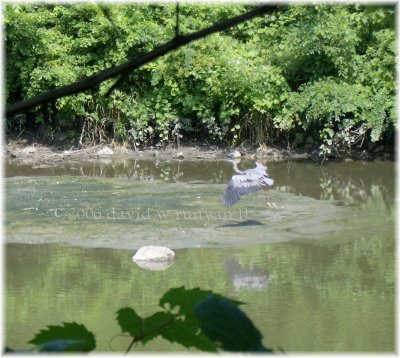
He seems a bit disheveled as he adjusts to becoming a pedestrian.
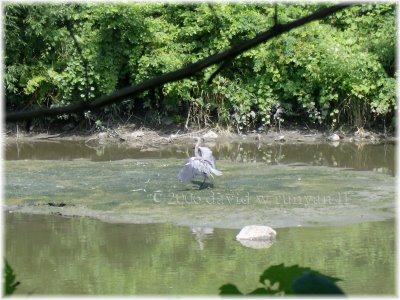
But rapidly regains his composure, again presenting as the stately creature he is perceived to be.
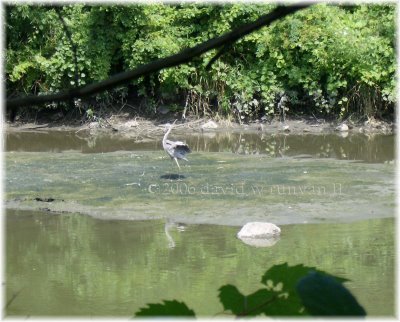
Bull Frog with the sun reflecting from his gorgeous golden eye.

In New England, this species is called Horn Pout; elsewhere it's known as Bullhead Catfish. As fish go, this one is a cutie. Little beady eyes, whiskers, an oval mouth and a yellow chin and puffy yellow belly. They don't come much more adorable than this fish.

One fine summer morning, I had a most lengthy and delightful encounter with a young buck, who, sensing safety by virtue of the creek separating he and I, remained in my company for the better part of an hour, satisfying his curiosity over me and granting me the opportunity to socialize with him and snap multitudes of close-range photographs.
At times, he was coyly shy, partially hiding himself behind the vegetation.

At other times, when I engaged him with my voice, he would position himself directly toward me and stare at me while I spoke; almost as if he cared to listen to what I was saying.

Almost always, his eyes we fixed upon me, as is natural for deer, to be alert for danger, but his other body languages convinced me that he understood my harmlessness.

Look at how many poses and glances this handsome young animal granted me before he slowly wandered off into the forest . . . few people have such wondrous encounters.




OK, a riddle and a test of your knowledge under duress. Which species is this?

. . . so . . . which animal is that? The female mallard of course! And the rectangular blue patches of the wing feathers are the only conclusive pieces of evidence which would help with a positive identification given the pose.

and then off she flew.

bottoms up ladies!

I spied a male mallard roosting on a fallen tree trunk in the thick of the swamp. He thought he was cleverly concealed, but insufficiently so to avoid detection by Mr. David's peering telephoto lens. :)

Painted turtle basking on a fallen tree at the wilderness fishing spot Mark and I discovered in Springtime. In the lower left, you can see a second turtle.

During a subsequent fishing trip, Mark caught a painted turtle, and you can see here how he transitions from yellow to orange to red, and he has lime-green eyes.

60x micrograph

This Quabbin resident weighs about 30 pounds and judging by his weathered face, I would guess that he's as old as his weight. The snapping turtle has a mythical reputation for being able to chomp off a man's arm. I've researched the matter and that's not true. But even so, he can inflict great pain.

. . . and a much smaller Quabbin relative of the snapper. . . the photomicrograph clearly shows the way this painted turtle's camouflage extends onto his retinas, and until now, I was completely unaware of the perfectly smooth tapered cylindrical design of his nostrils.

. . . and another Quabbin native . . . the box turtle.

This turtle I found in Chicagoland. I am unaware of his common name. He bears many similarities to New England turtles; including camouflaged retinas, but he has a significantly protruding snout.
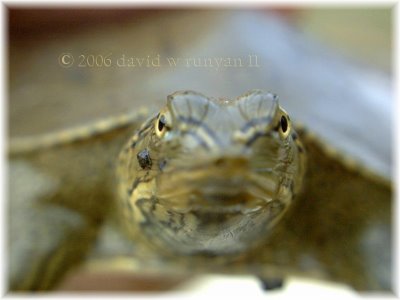
We have no snouted turtles in New England so this was a treat.

just look at this incredible little guy! i caught him accidentally while fishing for large mouth bass. New England turtles have legs and tails which are clearly distinct from the carapace and they extend from the sides. this turtle has legs and tail which seem to blend into the carapace and extend from the bottom. and he was a feisty one as well; nipping at me during the hook extraction process. good thing i use barbless hooks.

On a business trip to Pittsburgh, Mark spotted a family of ground hogs. They weren't very active, but they sure like to cuddle.

Some folks find canadian geese to be obnoxious nuisances. But I find them handsome and interesting birds with a natural tendency to be somewhat unconcerned for the existence of humans and their automobiles.

Every so often, one of them exercises their wings while afloat, in what I call the Water Ballet.

One morning, I came across a solitary goose, gliding in the lake peacefully, contentedly. She varied 25 - 75 yards away from me, so I employed the telephoto to capture her in her graceful glidings.




So, it really isn't the Canada Goose who is a nuisance. But I'll tell you which bird definitely is . . . this little red-winged blackbird. When they are raising their young, it is impossible to hike anywhere near the nest. These little birds will attack you and actually buzz your head with their wingtips. Pretty bird, but also pretty annoying.

The innocuous toad; the primary introduction to reptiles for most young boys; an excellent primer for the more precarious species.

The loon is an amazing bird, and in almost all cases, when you approach, she slips into the water and 5 seconds later, re-emerges some 50 yards away. One day while my sons and I were fishing in the Quabbin, we met this loon and she oddly allowed us to circle her continuously as she issued her haunting call.

out from under her wing slipped her baby! (to her left) now we knew why she was not evasive . . . to do so would have left her young far behind . . . sensing that our presence may be distressing her, we immediately navigated in the opposite direction, leaving her in peace.

This is the Sand Hill Crane. His body is as large as that of the great Blue Heron, but his wingspan isn't nearly as wide.
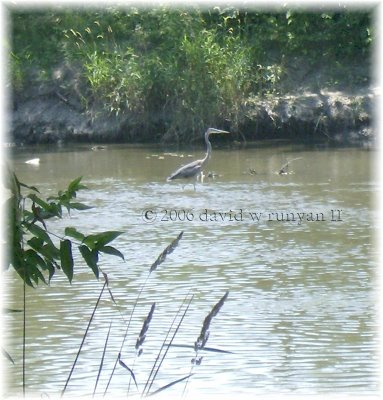
DoeFlections

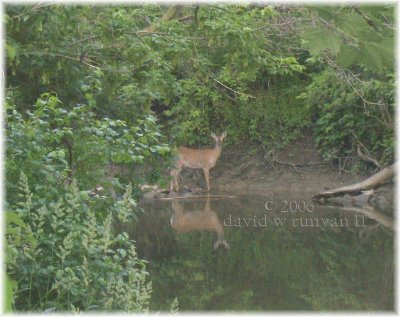
Buck Bonding
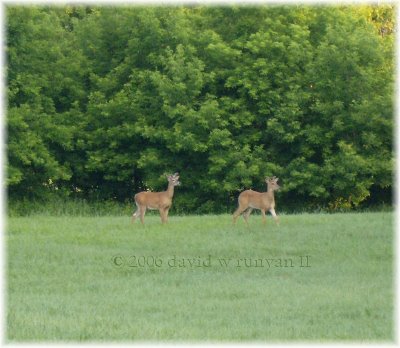
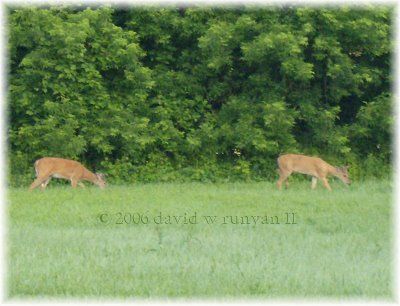
Young buck framing self perfectly between trees. It seems that these animals have an instinctive flair for aesthetic presentations in nature.
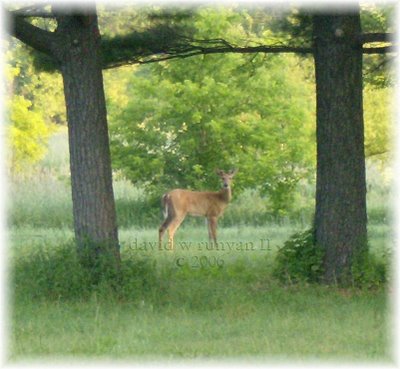
How precious is this? As I left the forest one day, this mother and daughter pair paused to satisfy their curiosity over me. If I saw deer several times each day of my life, I would never tire of the sight of these graceful, beautiful, peaceful animals . . . never.

SnoeDoe

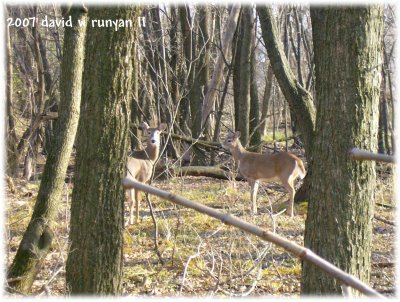
The white egret on the left looks hunched and sinister, while the other looks innocent and harmless, but to fish? . . . . . there is no such thing as a "good" egret.
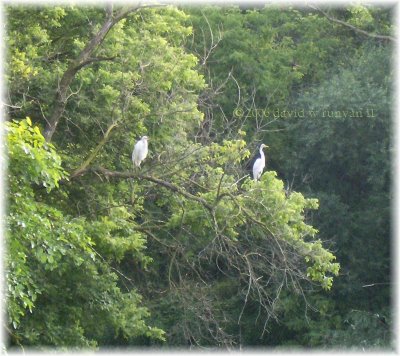
An Inland Egret Estuary.
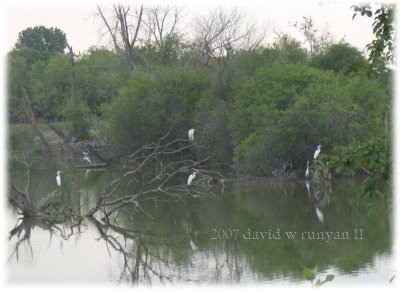
back to main page


No comments:
Post a Comment